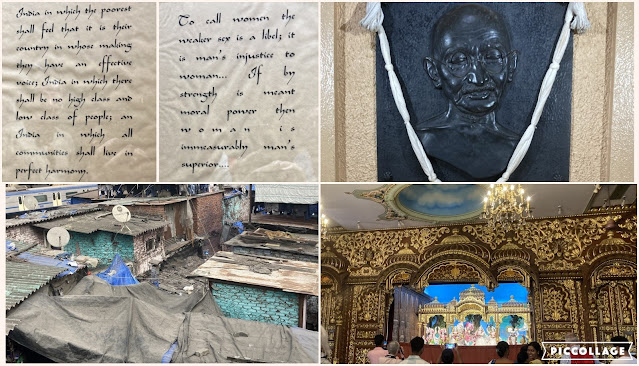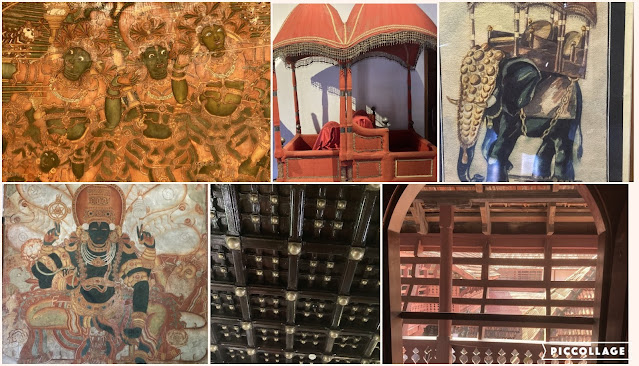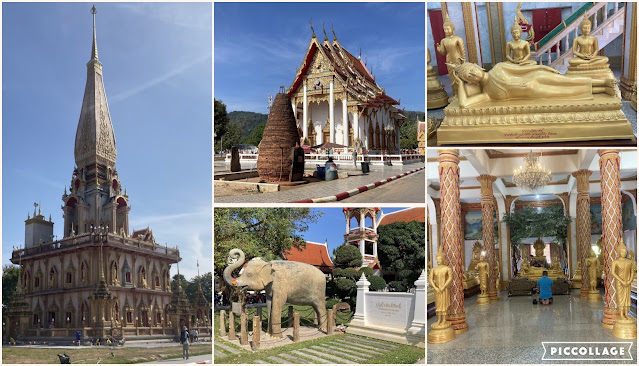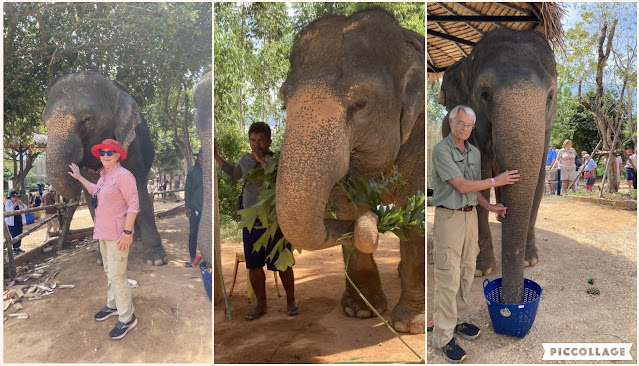A Holiday Cruise from Dubai to Singapore Onboard the Seven Seas Voyager
Although Scott and I have traveled extensively, we had not ventured to India yet. Frankly, we were both a bit nervous about visiting that country having heard tales of crowds and digestive illnesses and extreme poverty; so we decided to visit India via cruise ship. That way we could experience some of the country and its culture while returning to eat and sleep in the comfort of the ship. We compared several offerings and settled on an itinerary that included four different ports along the Indian coast as well as stops in Sri Lanka, Thailand, and Malaysia before ending in Singapore.
The option we selected was on the small luxury ship Regent
Seven Seas Voyager, which carries just 600 passengers. In addition to being an all-inclusive line
(shore excursions, gratuities, laundry service, etc.), the cruise price
included business-class air, one pre-cruise night in a Dubai hotel, and a
three-day post-cruise stay in Singapore.
In addition, this itinerary was offered during the Christmas-New
Years holiday period, which has become a time we enjoy traveling since we have
no children and no longer have parents.
The ship was beautifully decorated for Christmas and later
New Years but also had a Hannukah menorah on display in the main atrium
lobby. Services were held on board for
both holidays. We were in port in Mumbai
for Christmas Eve and Christmas Day and learned from our tour guide that
all religions celebrate the holiday there.
In fact, one of the hallmarks of each of the countries we visited in
South and Southeast Asia is their tolerance of multiple religious traditions.
 |
| A Buddhist Temple in Phuket, Thailand |
This photo (above) of a Buddhist Temple in Thailand is typical of many we visited. When we have traveled to Europe, tours invariable include a visit to one or more cathedrals. In this part of the world, it was temples, both Buddhist and Hindu. We were surprised by the number of towns in which these temples were located very near to a mosque, a cathedral, or a synagogue, so that peaceful co-existence seemed a reality. The photos in the collage below are from Klang, Malaysia where these religious buildings were all within two blocks of one another.
 |
| A Muslim mosque, Hindu temple, and Christian churches in Klang, Malaysia |
Our cruise began in Dubai. Unfortunately, we didn’t arrive at our hotel there until close to midnight, so we were unable to explore the city beyond a short walk after breakfast in a park near our hotel. We also watched from the bus windows as we drove across town to the pier. The bustling, modern city has some interesting architecture along with an unhealthy covering of smog.
 |
| Dubai as seen from our hotel room (right) and the bus (left) |
Our first port after leaving Dubai was at another city in the United Arab Emirates: Fujairah (fuh-gee-R-ah) in the Gulf of Oman. UAE is comprised of seven emirates (or states), each ruled by a sheikh; Dubai and Fujairah are the two largest and richest emirates. Fujairah is a major port for the export of oil produced in the country. Driving by bus to our shore excursion, we passed miles of oil storage tanks. There was new construction going up everywhere and evidence of the wealth that comes with oil production. We were also surprised to see mountains, reminiscent of our Arizna ones, all along the way.
 |
| Scenes from our bus ride through the emirate of Fujairah |
The shore excursion we booked was time at the Le Meridien Al Aqah Beach Resort where we spent a couple of hours enjoying the beach, pools, and sun.
We sailed across the Arabian Sea for two days before
docking in Mumbai, where we stayed for another two days. Scott and I took different shore excursions there. His was a bit more active than mine, since I
was recovering from the knee replacement I had had three months prior to this
trip; then to make my life a bit more difficult, I broke the little toe on the
“good” leg the first night on our ship! Scott
visited the Elephanta Caves while I opted for the “highlights”
tour of the city, which involved less walking and lots of bus time.
Mumbai is located on seven islands. The Portuguese attempted to colonized the area. The East India Company, acting on behalf of the British government, gradually acquired control of huge areas of India between the middle of the 18th and the middle of the 19th centuries, making India a major colony of the British Empire. Independence was won in 1947.
The Elephanta Caves, which were carved out of solid
basalt rock in the sixth century, contain many stone sculptures and reliefs of
Hindu gods and goddesses dedicated to Lord Shiva. The caves were discovered by
the Portuguese, who gave the island the name "Elephanta" for a large stone elephant statue found near the
shore. Unfortunately, they destroyed many of the sacred statues on the island by using them for target
practice.
 |
| Getting to and visiting the Elephanta Caves. There were a few monkeys inhabiting the island. |
Scott’s group reached the island by small boat, from which he was able to view the iconic Gateway of India and the beautiful Taj Mahal Palace Hotel (top right photo below). I viewed these from the other side on my tour (bottom right photo). The Gateway of India was constructed in 1914 to greet King George and Queen Mary. My photo was taken in the morning. When we drove by again in the afternoon, there was no available standing room! The Taj Mahal Palace Hotel was built by an Indian man after he was denied entrance to the Watson Hotel which catered to Europeans. To make sure the point was made, the Taj was a much grander hotel than the Watson. The Taj still stands and remains a luxury destination, while the Watson did not survive the test of time.
My tour took us by several historic parts of the city with a brief photo stop outside the massive Victoria Station (top left photo in the collage above). Our guide pointed out the Royal Theater (bottom left photo above), the original movie theater in town and now the place to view the latest Bollywood offerings. We drove by several athletic fields where people were playing the country's favorite game--cricket. The top center photo above shows one of these with the clock tower of Mumbai University, established by the British in 1857, in the background.
We stopped for a photo opportunity overlooking the Dhobi
Ghat, a famed outdoor laundry
where thousands of pieces of laundry are hand-washed, dried, and ironed each
day. The washer-men, known as dhobis,
are proud members of the Society that has been doing laundry this way for 140
years. They primarily do the laundry for
hotels and hospitals. Concrete tubs,
each fitted with a flogging stone, are filled with water (shown through the clothes lines in the top right photo below). For 18-20 hours each day, 7,000 men scrub,
dye, bleach, and dry items on rope lines.
We visited the Mahatma Ghandi memorial and museum, housed in what was the home of a friend where Ghandi lived for a few years. I photographed a couple of my favorite Ghandi quotes which were framed and hanging along the walls of the museum (top photos in the collage below). We walked from there to the temple of the International Society for Krishna Consciousness where people were chanting prayers offered for the welfare of humanity. Note the contrast between the opulence of the temple (bottom right photo) and the living conditions of the people in surrounding communities (bottom left photo).
The port in Mumbai was old, massive, and unattractive, so the
welcome to our next port—Mangalore—was a lovely change. Several of the other ports we visited on this
cruise were also very nice and provided scenic views of the areas.
 |
| Ports: Mangalore, India (left); Goa, India (top); Phuket, Thailand (right); and Colombo, Sri Lanka (bottom) |
The guide for our shore excursion in Mangalore was clearly
proud of his community. He told us that the
city (population about 800,000) is a
medical and education hub with more hospitals and colleges/universities than
anywhere else in India. (Wikipedia
reports a 94% literacy rate in Mangalore, compared with a 74% rate in India at
large.)
Our first stop was at the home of Joan Peres, a wealthy
86-year-old woman who welcomed us warmly. She had borne seven children between 17 and
25. She laughed as she told another
woman and me, “We had no birth control and no TV, and I had to keep my husband
happy.” The Peres family has occupied this
colonial-style home surrounded by beautifully manicured tropical gardens for
generations. Each of the five bedrooms has its own bathroom, separated by either a curtain, as in the pink bedroom shown below, or a folding door. In the butler’s pantry off
the kitchen a mechanized pestle was grinding spices for making curries (center left photo below).
After the visit to the Peres home, we went to the markets. We walked through the fish market and then
through the dried fish market. During
the rainy season (May through September) fishing is difficult so the people eat
the dried fish (soak before cooking).
The next port was Cochin in the Indian state of Kerala. One of my favorite books last year was “The Covenant
of Water,” by Abraham Verghese. The
novel was set in Kerala, and getting to stop here was one of the main reasons I wanted to sail on
this particular itinerary.
Unfortunately, I didn’t get much of a sense of the setting of the novel,
but nevertheless, we had an interesting tour of the town.
We visited what our guide called “a small Portuguese palace.”
The Mattancherry Palace was built by the Portuguese in the 16th century as a
gift for the Maharaja of Cochin in exchange for trading rights. Of most importance were the spices that were
cultivated here, among them black pepper, cardamom, cinnamon, clove, and
nutmeg. Of these, black pepper was the most prized. Because of its scarcity and worth it was
known as "black gold."
The photos below were taken in the palace. One (bottom center) shows the teak and brass ceiling of the dining room. The brass globes were polished daily to reflect sunlight which provided light before electricity was available. There were wall murals throughout the palace, usually depicting the Hindu god Vishnu, who was considered the supreme deity of the Royal family. Several palanquins, used to transport royalty, were also on display, including the orange one shown below. These were either carried by elephants or slaves.
We also visited an historic church (19% of Cochin’s population is Christian) and a synagogue. The Jewish influence was strong in Cochin in the 1400 and 1500s, but the current Jewish population has dwindled to 25. The main characters in "The Covenant of Water" were Saint Thomas Christians, initially converted by the apostle Thomas who sailed to Kerala in the first century.
We took a boat ride and viewed Chinese fishing nets, which are dropped into the water and then pulled up full of fish.
 |
| Chinese fishing nets (top photos), the colorful inside our tour bus (bottom left), and a spice market. |
Leaving India, we docked in the capital city of Sri Lanka--Colombo. Sri Lanka, an island nation in the Indian Ocean, was known by its British colonial name of Ceylon until 1972. As is true for most of the places we visited on this cruise, the Portuguese were the first Europeans to exert influence over these lands, exploring the region and establishing trade routes in the 1500s. The Dutch drove the Portuguese out in the 1600s, and were followed by the British who took control in the early 1800s. After World War II, the British Empire began to fray and many former colonies became independent countries, sometimes peacefully, but often with bloodshed. Sri Lanka was of the latter variety, and a series of civil wars and terrorist insurrections have plagued the country periodically over the past fifty years.
Scott went on a shore
excursion in the city of Colombo, but I stayed close to the ship since my
broken toe needed a rest. Among the
sites he visited was the Gangaramaya Temple, the largest in Colombo, and home
to a Buddhist learning center. The photo
of the Buddha in the park (top right photo in the collage below) was taken from the government building across the
street. The belief is that such a
placement of a Buddha brings good luck to the work in the building opposite.
Next, we docked at the southern end of Phuket Island, Thailand. There we visited a Buddhist temple complex, Wat Chalong. These photos show several of the temples, inside and out. To enter a temple, you must remove your shoes and hats and have shoulders and knees covered. In front of one of the temples, there is a chimney where worshippers traditionally express gratitude for answered prayers by lighting firecrackers (top center photo in collage below). When these went off, it was incredibly loud!
Next, we went to a
cashew-processing factory. Cashew fruit grows on a cashew tree (right photo below). The
fruit is eaten. The seeds inside the
cashew plant are boiled, then dried, and then the shell is smashed to remove
the nut, which is a labor-intensive enterprise. In the photo below, a worker is breaking the seed shells from the pile on the right and sorting the freed nuts--whole nuts go into one red bowl and pieces go in the other.
Our last stop in
Phuket was at an elephant sanctuary for about 15 retired elephants, aged 60 to
70. In Thailand, elephants are
domesticated for heavy work, and, like their human counterparts, are allowed to
retire in their later years. Scott
volunteered to mix “vitamin balls.” He squeezed together rice, bananas, squash,
and tamarind and formed this into a large ball which would later be injected
with vitamins and fed to the elephants. We
fed the elephants watermelon, sugar cane, and pineapples. They seemed to like the watermelon best. We also gave them some banana leaves, which they
grabbed from our hands, tore into pieces, and munched contentedly. It is amazing what elephants can do with their
trunks! The elephants allowed us to pet
them. Their skin is rough and hairy.
From Phuket, we sailed to Penang Island, Malaysia. A former British colony, Penang's main city is George Town. A clock tower was erected to
celebrate Queen Victoria’s 60th year as queen. (The top right photo in the collage below shows George Town from the ship with the clock tower in the middle. The tower up close is in the top middle photo.) As we drove through town and
across the island, our guide told us about the things we were passing: beaches, five-star hotels (Park Royal,
Shanghai, and Hard Rock among them), houses on Millionaire Road (one is shown in the bottom left photo), and a mosque (top left).
The majority population in Malaysia is Malay Muslim but on the island the
majority are Chinese, who might be Buddhist, Hindu, or Christian.
The highlight of our shore excursion was a visit to a batik
factory where we learned about the technique and then painted our own
scarves. Batik can be made using block
prints. The craved block is dipped into hot wax and stamped repeatedly on the
fabric to create a design, or the design is drawn by an artist using a wax
pen. Paint is then applied using a
brush. The wax lines keep the colors
from running into one another. After the
paint dries, the fabric is washed to remove the wax. We each had a pre-drawn design to paint on a
piece of cotton cloth. When we finished,
the factory set and washed our work and delivered them to the ship.
 |
| Photos on the left and bottom center show the artisans at the center creating batik. The other photos show Scott's and my work and our finished products. |
Our next port was on the Malaysian coast between the towns of
Klang and Kuala Lumpur. We opted for an
excursion to Klang as it was the closer and smaller of the two cities. We were taken first to Little India. According to our guide, Indians came to
Malaysia in the 1800s with the British, and have since continued to live in
their own communities.
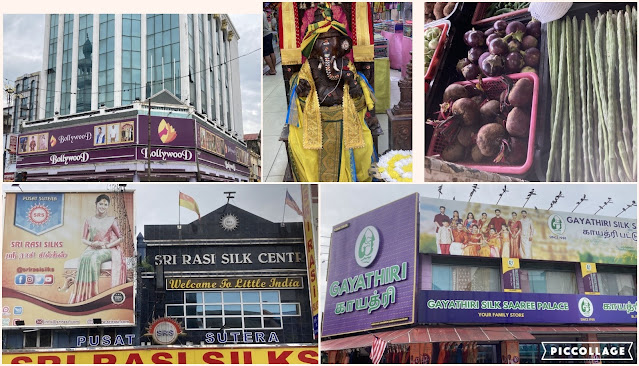 |
| Scenes from "Little India," including clothing stores and the Bollywood Theater. |
We visited the Royal Museum of the state of Selangor, the
most developed of the Federation’s states.
The former British Governor’s home has been converted into a Royal
Museum. While we learned about the
ruling royal family of sultans, we weren’t allowed to take photos.
We had mulberry tea and cakes at this traditional “wooden
house,” now a restaurant and museum with rooms furnished as they would have
been in the 1950s.
We then walked across the street to a Taoist shrine (photos on the left and bottom) and then
to the Buddhist temple, which was next door. A female lion, with her cub, sits
outside the Buddhist temple. Scott climbed the stairs to see the rooftop
Buddha, the largest marble one in Malaysia.
Our last Malaysian port was the town of Melaka. Like other parts of this region, Melaka was
occupied by the Portuguese, the Dutch, and the British, but it is the Dutch influence
that seems to have had the most lasting influence. Here are some of the photos reflecting
that: the Dutch church (left), a square with a
windmill and dairy cows (top center), and the shops along the canals. The replica of a Portuguese ship, Flor De La
Mar, sits near the harbor.
Our cruise ended in Singapore, where we spent four days, the first of which was beautiful and sunny, followed by three days of rain. Fortunately, Scott was able to get some photographs of Singapore’s diverse architecture while the sun was out. His tour guide told them that each new building must be architecturally different from those that have already been built. The city/state’s official mascot is the Merlion, which spews water into the Singapore River. The Merlion is both lion and fish reflecting Singapore's moniker of the "lion city" and its origins as a fishing village.
Fortunately, we began our rainy-day tour with a visit to a multi-story domed indoor garden at the Gardens by the Bay. This botanical garden contains a gorgeous orchid collection as well as a cloud forest and gardens from around the world. Scattered throughout the gardens were wooden sculptues of animals, which we thought were charming.
We donned rain ponchos and crowded into the covered section of a river boat for a short tour of the Singapore River. Next was a ride on the Singapore Flyer, a 165 meter (540 feet) “giant observation wheel.” The rain and clouds obstructed our view of the city, but it was still an enjoyable experience. I did not have a photo of the Flyer but downloaded one from the internet, which I included in the collage below. We rode in enclosed capsules, like the one shown below in the top right photo. The two domed structures you can see in the commercial photo and in my rainy one house the gardens we had visited.
Rainy day number two took us for a stroll
down Waterloo Street, a pedestrian mall lined with flower kiosks and home to
Buddhist and Hindu temples, a mosque, and a synagogue. According to our guide, the flower shops are
handed down in a matriarchal line, from mothers to daughters. We walked by the temples and the mosque but
had to do a drive-by of the synagogue since it was raining so hard.
 |
| Flower stalls (left), Buddhist temple (top center) with worshipers lined up to offer prayers (top right), mosque (center bottom), and Singapore bridges (bottom right) |
 |
| Hindu temple showing details of the building; worshiper in red |
Singapore was getting ready for the start
of the Chinese New Year celebrations which were just a week away.
We spent some time at National Museum of
Singapore, which we found to be fascinating.
Here are a few items from the museum.
The Chinese influence in Singapore included the prevalence of opium
dens (bottom left photo). The Japanese invaded Singapore
during World War II and significantly outnumbered the Allied troops. The POW conditions were difficult (aren’t
they everywhere?) (top right photo). Children celebrate
the liberation of the country (bottom right photo).
There were no formal activities scheduled for our last day in Singapore, so Scott went out exploring on his own. Among the things he found was an outdoor spice museum. He found the ship constructed of cloves (bottom right photo) a most interesting item.
By the time we arrived home, we had been traveling for four weeks. We enjoyed our time on the ship and visited several interesting ports. We also met some delightful fellow travelers. Perhaps I will write another blog about some of them, but I will end this one with one last collage. Best wishes to all for a wonderful 2025, which we launched on the Seven Seas Voyager.



